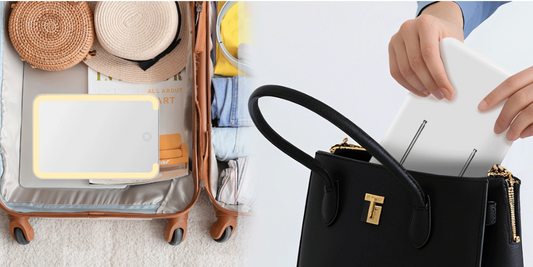The concept of mirrors as we know them traces back to as early as the Roman times, which was dated around the 14th century. Long before man-made mirrors were used, people used them for different purposes such as viewing their own reflection, for decoration, as scientific instruments, and even for entertainment. Seeing their reflection was considered a magical moment, and they would do this by looking into pools of water, clay vessels filled with seemingly dark water, streams, and rivers.
While glass mirrors are the most commonly used material today, the ancient Egyptians, Mesopotamians, and Chinese made mirrors with a variety of materials including copper, tin, steel, bronze, silver, and gold. Others were made of a brittle alloy of copper and tin, also known as “speculum metal,” which was a highly reflective surface. They would flatten sheets of metal and polish them until they could see a clear reflection. The mirrors were round in shape and were often attached to metal, wood, or an ivory handle with designs and other embellishments on the back. The creation of this type of mirror was considered difficult to make, pricing them at a much higher value. Therefore, only the elite could afford to possess them.

It is believed that the first metal-coated glass mirrors were first introduced in Sidon, Lebanon in the first century A.D. Once this was discovered, the Romans recreated them and were finished with a metal layer. They were also used in Roman graves during the third and fourth centuries. These metal handheld mirrors eventually spread throughout Europe and parts of Asia.
Most cultures would decorate them with ornate carvings or images of gods. They were sold about three inches in diameter, although many people preferred metal mirrors since glass mirrors did not have as good of a reflection. Mirror making was considered an art, but during the Dark ages, it became a lost art when different cultures and the economy decimated.
During the Renaissance, there was a renewed interest in mirror making. The Europeans figured out how to properly coat glass using tin-mercury amalgam to create a better reflective surface. And with skilled glass artisans from Venice, they became well-known for producing some of the most high-quality mirrors in the 1500s. They even sold matching vanity sets, which would often include a comb or hairbrush, and a handheld mirror.
In 1835, the first modern mirrors started to appear thanks to Justus von Liebig who developed a technique for coating glass with silver. He used a thin layer of metallic silver by depositing the metal directly through a chemical reaction. He applied a solution of silver nitrate in ammonia to the glass, and then exposed it to vapors of formaldehyde.
In the late 1800s, most middle or high-class households would have a handheld mirror for every bedroom or bathroom. These mirrors would be made out of hand-cut and beveled mirror glass set in brass or silver. In Europe, handheld mirrors also became popular, specifically hand-painted mirrors with porcelain backs.
With the rich history of the beautiful pieces that makeup handheld mirrors, over time they have become significantly valued among society. While they may not hold the same level of admiration as the countess above, they are still one of the most important tools in our vanity. Not only are they considered to be every woman’s best friend, but they also come in handy for men.
That being said, our team at Omiro Mirrors takes great pride in our affordable collection of handheld mirrors. Our newly launched LED handheld mirror is the ultimate multi-functional makeup organizer, making it the perfect combination of a contemporary and stylish tool. It has two round-shaped mirrors on the front and back with 1X and 10X magnification. It has a LED lighted ring surrounding the mirror with 3 color modes including warm, cold, and natural. It also comes with special features such as a touch button and a USB charging port, making it perfect for traveling. Its transparent base is one of a kind and convenient for storing makeup essentials.

So if you are looking for a functional and minimalistic handheld mirror, then Omiro’s LED handheld mirror is an excellent choice for you. Not only is it practical, but it is exquisite with its Scandinavian style. To view this item, you may visit our website at www.omirro.com and follow us for the newest items in our collection. Otherwise, you may follow us on our social media accounts.
Copyright © 2021 Omiro. All rights reserved.






